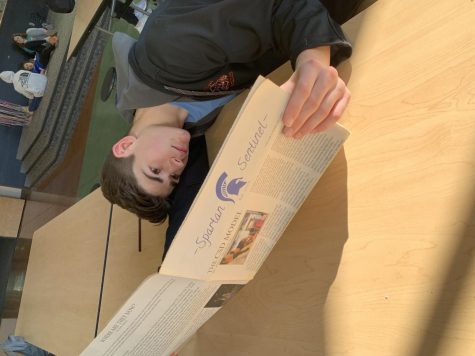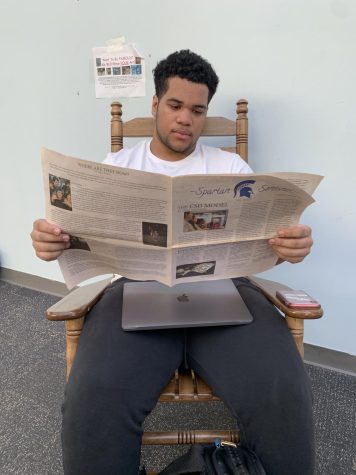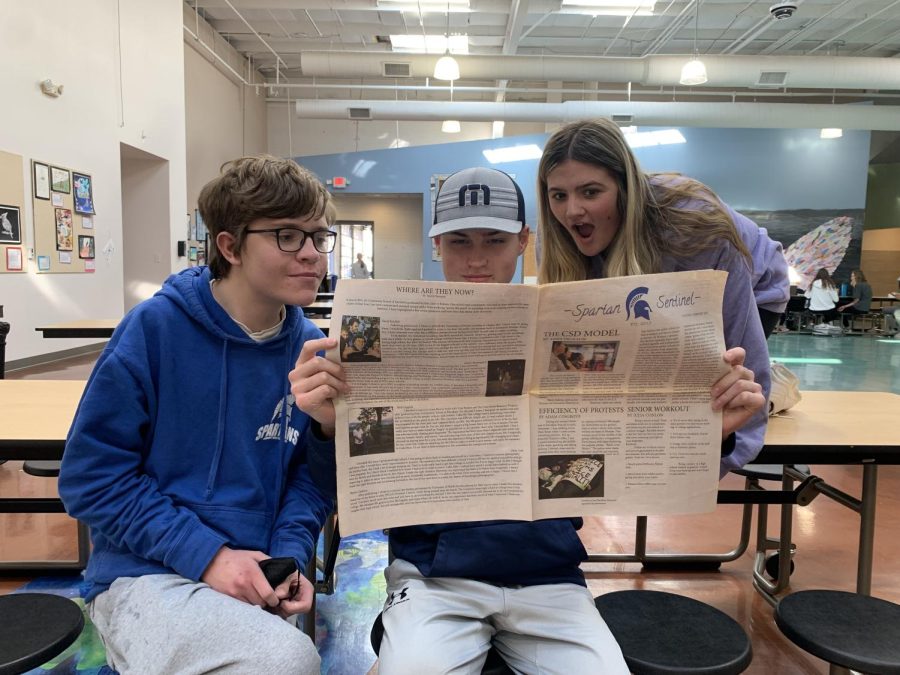What happened to the once popular newspaper?
Left to right respectively: Evan Mulligan (’26), Conner Shelton (’25) and Emma Burch (’25) share the only issue of the Spartan Sentinel that came out in print. The Internet and online news changed many things.
January 9, 2023
Not too long ago, kids had paper routes, newspaper stands stood on the corner of every street and savvy business travelers had a gazette tucked up under their arms. But those days have passed and printed newspapers are largely a relic.
Newspapers once dominated the news market. In the 1980s – the peak of the newspaper – roughly sixty-three million copies were distributed daily. These numbers fell steadily as years passed due to the rise of the Internet, with an estimated 25% of all American newspapers dwindling out of circulation in the past fifteen years, reported by The New York Times. This is due to the increasing ease of the Internet and the relative cost of newspaper production compared to their online counterparts.
News delivery now looks very different. Currently, just under 16% of the United States population cites getting its news from newspapers while social media floats above it at 20%. Television is the largest source of news, 49%, according to CNBC.
In February 2015 at the Community School of Davidson, the Spartan Sentinel newspaper ran its first and only issue. The eight page foldout consisted of seven feature length stories and sixteen photos and graphics, ranging from a collection of fifteen senior quotes to a piece about habits in our daily lives. The featured article – titled ‘Where are They Now?’ – was a forty-nine-line article covering the post-high school lives of five CSD alumni: David Katibah, Hailey Beauregard, Nick Coppola, Daisy Cole and Bayley Cashion. The story followed their journeys once they graduated while also including their plans for the future.

The reasons behind the newspaper only running once were numerous. Limited class time and a lack of funding were two key factors. The journalism team, the drivers of the publication, only met three times a week for a total of five blocks which constricted the amount of time for students to write. Another limitation was printing cost. Few printing companies were willing to run the small batch of papers needed by the Spartan Sentinel at a cost which fit budget.
Mrs. Kimberly Keith, the founder of the Spartan Sentinel and previous teacher of the Journalism class, said, “Most of the students who really advocated and worked on the print issue graduated that spring…I think there could be more print issues if there was a group of students dedicated to pursuing the project.”
Seven years later, the decision to run a school newspaper is still a complex one. Perhaps the most central factor is the fluctuating enthusiasm of the students and teachers.
Molly Feighery (‘24) said, “I’d read it if it was interesting, and if I didn’t have to pay.”
Gordy Anderson (‘24), Oliver Morris (‘25) and Logan DuBois (‘25) echoed her opinions.
On the contrary, since the Spartan Sentinel is now published virtually, Mr. Mark Houlihan, the Technology teacher, said, “If I had the paper in front of me I would read it, but I feel like I would gravitate towards the online paper otherwise.”
Elaine Thompson (‘23) said, “I would read the paper because I don’t like the online one…I would say I’d pay three bucks max for the paper.”
One teacher still relishes the material newsprint.
“I would read the printed version. I just like the feel more and when I’m online I feel like I can click away from it at any time,” said Mrs. Jennifer Chaffman, a teacher who dons many hats (including yearbook, media production and class advisory) here at CSD. “I’m an empty nester and I love to have something to read at the dinner table. A paper is the perfect thing.”

Does paper newsprint still have a place in society and at CSD? While some teachers and students would love a tangible newspaper, in all likelihood it is not a feasible option.
Ms. Amy Tomalis, head of the upper school, cited the high cost of production as the major limiting factor.
For the foreseeable future the printed paper will remain in the past, the days of paper routes and newspaper stands long gone. The trend towards electronic news is gaining steam.
But perhaps there is still hope. At CSD, the student journalists have initialized many changes to the school’s online news site and a printed paper, even just one annual issue, just might be in the future.




Joy Warner • Jan 12, 2023 at 6:06 pm
Loved reading this article! An annual hard copy sounds like an interesting endeavor! Great work, Ben and team! I read two newspapers (electronically I confess) daily!
Love, Ms joy